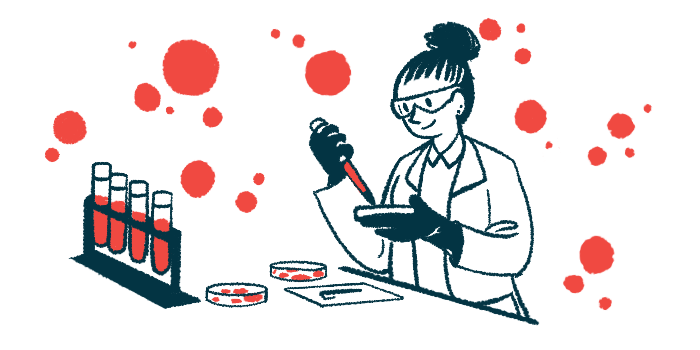Work supports Nurr1 as target of potential disease-modifying therapy
Activating protein protected neurons, eased motor and smell deficits

Activating the Nurr1 protein eased both motor and smell deficits and showed neuroprotective properties in mouse and cell models of Parkinson’s disease in a recent study.
The newly developed Nurr1 activator, called 4A7C-301, also did not induce dyskinesia, the involuntary movements associated with certain standard Parkinson’s treatments, in the animals.
Scientists believe that 4A7C-301, or similar molecules, “may warrant clinical evaluation … for the treatment of patients,” with the possibility of being a disease-modifying therapy for sporadic and familial Parkinson’s.
The study, “An optimized Nurr1 agonist provides disease-modifying effects in Parkinson’s disease models,” was published in Nature Communications.
Lower Nurr1 protein levels being seen in the brains of patients
In recent years, studies into the role of Nurr1 in Parkinson’s disease has positioned the protein as a therapeutic target for the neurodegenerative condition.
Nurr1 is essential for the development, maintenance, and protection of dopaminergic neurons, which are progressively lost in Parkinson’s. As their name suggests, these nerve cells produce dopamine, a key chemical messenger in the brain.
The protein works to boost the activity of genes involved in dopamine production, while also repressing inflammatory gene activity to have an overall neuroprotective effect.
Research indicates that Nurr1 is diminished in the brains of people with Parkinson’s disease.
In previous work, a group of scientists at Harvard University and the University of Delhi in India screened approved drugs in the U.S. that could enhance the activity of Nurr1, identifying three: amodiaquine, chloroquine, and glafenine.
All these compounds share an identical chemical core structure called 4-amino-7-chloroquinoline (4A7C), which they believed to be important for their ability to activate Nurr1.
These researchers now aimed to develop 4A7C derivatives with a more potently activation capacity and a better ability to reach the brain than those three compounds.
Starting with chloroquine — relatively safe and widely used in treating malaria — the scientists tweaked its chemical structure to make more than 570 different molecules.
Ultimately, they narrowed their work to one final candidate, 4A7C-301, that appeared to have the strongest ability to activate Nurr1 and reach brain tissue when given to rats.
Nurr1 activator had range of neuroprotective and anti-inflammatory effects
Across a range of cell culture experiments, the scientists demonstrated that both chemical and genetic Parkinson’s-related insults led to a reduction of Nurr1 similar to that seen in patients.
“Compromised expression/function of Nurr1 may underlie degeneration of [dopaminergic neurons] in both familial and sporadic [Parkinson’s],” the scientists wrote.
4A7C-301 demonstrated an ability to bind to Nurr1 and increase its levels in cells exposed to MPP+, a toxin widely used to induce Parkinson’s disease-like symptoms in animal and cell models. While chloroquine also did, the effects of 4A7C-301 were more potent.
The scientists determined that the molecules likely boost Nurr1 by making the protein more stable and less vulnerable to toxins.
4A7C-301 also induced a range of neuroprotective and anti-inflammatory effects in cell cultures. These neuroprotective effects are likely related to the molecule’s ability to increase Nurr1 levels, and to its capacity to boost Nurr1’s activity seen as protective of dopaminergic neurons, the scientists wrote.
Chloroquine suppresses a cellular process called autophagy, through which old, damaged, or unneeded proteins are broken down. Notably, 4A7C-301 was not found to inhibit autophagy, but rather to protect against it.
This finding is “an important distinction,” the scientists noted, given that problems with autophagy in cells increasingly is recognized as contributing to Parkinson’s disease.
Based on these cell study results, the scientists wondered if 4A7C-301 could show disease-modifying potential in Parkinson’s animal models.
Mice in 2 distinct disease mouse showed lesser motor, smell deficits
Using two mouse models, representing environmental and genetic risk factors for Parkinson’s, they found that 4A7C-301 eased the animal’s motor and smell defects, as did chloroquine, although with less potency. Levodopa, a standard Parkinson’s treatment, also works to ease motor symptoms, but it cannot address smell dysfunction.
“Another interesting finding … is the observed olfactory deficit in both [mouse] models, and that 4A7C-301 (and [chloroquine] to a lesser degree) significantly rescued this deficit, suggesting … that Nurr1 agonists may ameliorate at least some of the non-motor deficits of [Parkinson’s disease] as well,” the researchers wrote.
Notably, neither 4A7C-301 nor chloroquine induced dyskinesia, a common side effect of levodopa treatment.
Consistent with the cell studies, these molecules were able to protect dopaminergic nerve cells in the brains of the mice and inhibit neuroinflammation to a greater degree than levodopa.
While study findings support the potential value of 4A7C-301 in treating Parkinson’s, the researchers noted that more work is needed into the molecule’s limitations, the effects of which are not fully clear. For example, “the potential off-target effects and toxicities of 4A7C-301 need to be fully addressed,” they wrote.
Still, they concluded that “Nurr1 represents a promising target for the development of neuroprotective therapeutic agents” for Parkinson’s disease.
“Optimized targeted agonists [activators], such as 4A7C-301 or its analogous compounds, may have the potential as mechanism-based, disease-modifying treatments for both sporadic and familial [Parkinson’s],” the team wrote.







